
This is a timeline of Mongols prior to the Mongol Empire.

This is a timeline of Mongols prior to the Mongol Empire.
| Year | Date | Event |
|---|---|---|
| 700 | Chinese records mention a tribe called "Mengwu", probably pronounced "Mung-nguet" at the time, inhabiting Manchuria [1] |
| Year | Date | Event |
|---|---|---|
| 908 | Abaoji attacks the Shiwei [2] |
| Year | Date | Event |
|---|---|---|
| 928 | Khongirad rebels against the Liao dynasty in the north [3] |
| Year | Date | Event |
|---|---|---|
| 950 | Chinese records mention a "Mengwu" tribe living in the grasslands west of the Greater Khingan and southeast of Lake Baikal [1] |
| Year | Date | Event |
|---|---|---|
| 965 | Khongirad and Shiwei tribes rebel against the Liao dynasty [4] |
| Year | Date | Event |
|---|---|---|
| 997 | Zubu Poosy rebel against the Liao dynasty [5] |
| Year | Date | Event |
|---|---|---|
| 1007 | Zubu tribes rebel against the Liao dynasty [5] |
| Year | Date | Event |
|---|---|---|
| 1050 | Khaidu, "the first to rule all the Mongols", is born [6] |
| Year | Date | Event |
|---|---|---|
| 1069 | Zubu tribes rebel against the Liao dynasty [5] |
| Year | Date | Event |
|---|---|---|
| 1084 | "Mengwu" visit the Liao dynasty court [1] |
| Year | Date | Event |
|---|---|---|
| 1100 | Khaidu dies [6] |
| Year | Date | Event |
|---|---|---|
| 1118 | Zubu tribes rebel against the Liao dynasty [5] |
| Year | Date | Event |
|---|---|---|
| 1146 | Khabul Khan of the Khamag Mongols, great-grandson of Khaidu, rebels against the Jin dynasty [7] |
| Year | Date | Event |
|---|---|---|
| 1160 | Conflict with the Jin dynasty reduces the Mongol tribes and the Borjigin clan to destitution [6] | |
| 1162 | Temüjin is born in Delüün Boldog near Burkhan Khaldun to the Mongol chieftain Yesugei and Hoelun [8] |
Borte Chino (Grey Wolf) and his wife was Gua Maral (White Doe)
---
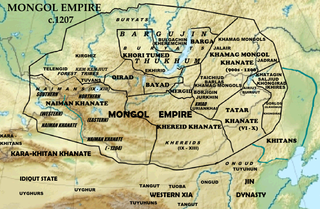
A Borjigin is a member of the Mongol sub-clan, which started with Bodonchar Munkhag of the Kiyat clan. Yesugei's descendants were thus said to be Kiyat-Borjigin. The senior Borjigids provided ruling princes for Mongolia and Inner Mongolia until the 20th century. The clan formed the ruling class among the Mongols and some other peoples of Central Asia and Eastern Europe. Today, the Borjigid are found in most of Mongolia, Inner Mongolia and Xinjiang, and additionally genetic research has shown that descent from Genghis Khan and Amir Timur Barlas is common throughout Central Asia and other regions.
The family tree of Genghis Khan is listed below. This family tree only lists prominent members of the Borjigin family and does not reach the present. Genghis Khan appears in the middle of the tree, and Kublai Khan appears at the bottom of the tree. The Borjigin family was the imperial house of the Mongol Empire (and its various successor states, dating back to the 13th and 14th centuries.
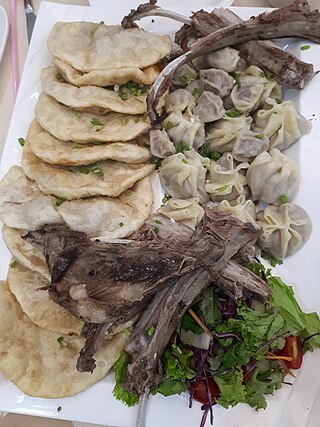
Mongolian cuisine predominantly consists of dairy products, meat, and animal fats. The most common rural dish is cooked mutton. In the city, steamed dumplings filled with meat—"buuz"— are popular.
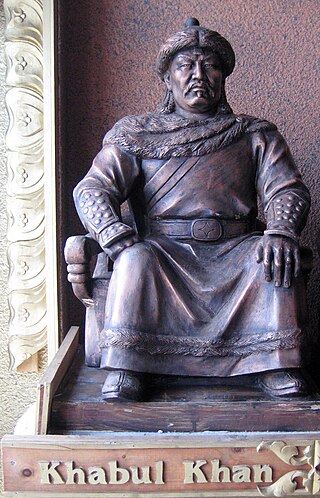
Khabul Khan, also rendered as Qabul Khan, Kabul Khan and Khabul Khagan, was the founder and first known Khan of the Khamag Mongol confederation and great-grandfather of Genghis Khan, and brother of Khaduli Barlas, who was in turn the ancestor of Timur. He was the son and successor of Tumbinai Khan.
Hotula Khan or Qutula Khan was a Khan of Khamag Mongol and the son of Khabul Khan, and thus great-uncle of the Genghis Khan, and the nephew of Khaduli Barlas who was the ancestor of Barlas Mongol clan, where Central Asian conqueror Timur originated and foundation of Timurid Empire.
Ambaghai or HambaqaiKhan was a Khan of the Khamag Mongol, succeeded to his cousin Khabul Khan, he was one of the great-grandsons of Khaidu Khan and the cousin and predecessor of Hotula Khan, he was the Leader of Taichud Clan one of sub-branch of Borjigid, and also Grandson of and successor of Charaqai Lingqum.

The Four Garrisons of Anxi were Chinese military garrisons installed by the Tang dynasty between 648 and 658. They were stationed at the Indo-European city-states of Qiuci (Kucha), Yutian (Hotan), Shule (Kashgar) and Yanqi (Karashahr). The Protectorate General to Pacify the West was headquartered in Qiuci.

Alan Gua is a mythical figure from The Secret History of the Mongols, eleven generations after the grey wolf and the white doe, and ten generations before Genghis Khan.
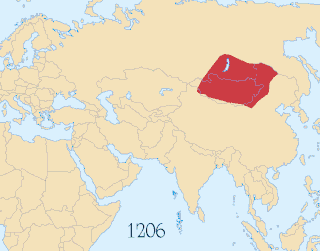
This is the timeline of the Mongol Empire from the birth of Temüjin, later Genghis Khan, to the ascension of Kublai Khan as emperor of the Yuan dynasty in 1271, though the title of Khagan continued to be used by the Yuan rulers into the Northern Yuan dynasty, a far less powerful successor entity, until 1634.
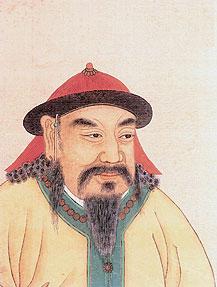
Yesugei Baghatur or Yesükhei was a major chief of the Khamag Mongol confederation and the father of Temüjin, later known as Genghis Khan. He was from the Borjigin family, and his name literally means "like nine", meaning he had the auspicious qualities of the number nine, a lucky number to the Mongols.

Bodonchar Munkhag was a renowned Mongol warlord and a direct ancestor of Genghis Khan as well as of the Barlas Mongols, the tribe of the Central Asian warlord Timur.

Tüsheet Khan refers to the territory as well as the Chingizid dynastic rulers of the Tüsheet Khanate, one of four Khalka khanates that emerged from remnants of the Mongol Empire after the death of Dayan Khan's son Gersenji in 1549 and which continued until 1930.
The siege of Lüshun was a military conflict between the Later Jin and Ming dynasty. In the summer of 1634 the Jin attacked and conquered the port city of Lüshun from Ming.

This is a timeline of the Jurchens.

This is a timeline of the Five Dynasties and Ten Kingdoms (907–979), which followed the collapse of the Tang dynasty in 907 AD. The Five Dynasties refer to the succession of dynasties which ruled northern China following the Tang collapse while the Ten Kingdoms, with the exception of Northern Han, ruled in southern China. This era of division ended in 979 AD with the rise of the Song dynasty under Emperor Taizu of Song, although the Song would never reconquer the northern territory lost to the Khitans, collectively known as the Sixteen Prefectures.
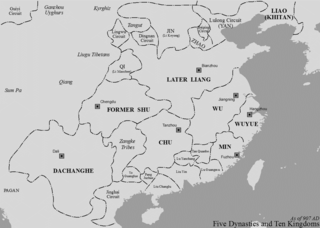
This is a timeline of the Tangut people and Western Xia.
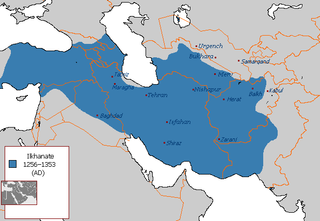
This is a timeline of the Ilkhanate.

Yunnan under Ming rule saw the continuation of the tusi system instituted during the Yuan dynasty, increasing centralization, and Han migration into Yunnan.
The rise of Genghis Khan involves the events from his birth as Temüjin in 1162 until 1206, when he was bestowed the title of "Genghis Khan", which means something along the lines of "Universal Ruler" or "Oceanic Ruler" by the Quriltai, which was an assembly of Mongol Chieftains.

The Jurchen unification were a series of events in the late 16th and early 17th centuries that led to the unification of the Jurchen tribes under Nurhaci, a Jianzhou Jurchen leader who had an antagonistic relationship with the Ming dynasty due to their involvement in events early on in his life that led to the death of his father and grandfather. From 1583 to the early 1600s, Nurhaci led a series of military and influence campaigns that led to the unification of the majority of the Jurchen tribes. In 1616, Nurhaci established the Later Jin dynasty and ruled as its founding khan.